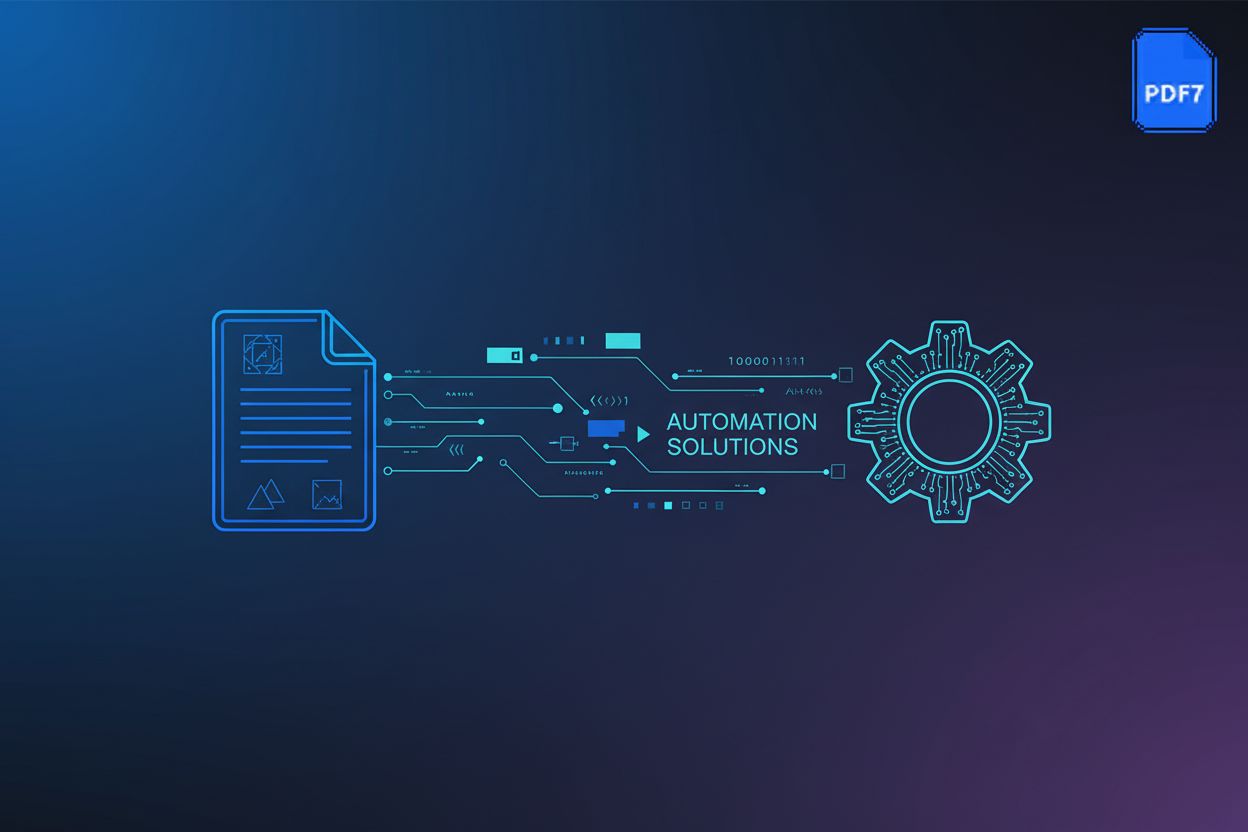Implementing PDF Digital Rights Management (DRM): A Comprehensive Guide
TL;DR
Understanding PDF DRM
Did you know that the U.S. economy loses nearly $30 billion annually due to digital piracy? Protecting digital assets is crucial, and that's where PDF Digital Rights Management (DRM) comes in.
Digital Rights Management (DRM) refers to technologies used to protect copyrighted digital materials. It aims to control access, prevent unauthorized copying, and restrict usage of digital content. DRM is essential for safeguarding intellectual property and revenue streams in various industries. For instance, it stops unauthorized sharing of sensitive financial reports, preventing competitors from gaining an unfair advantage. Similarly, it ensures that eBook publishers get paid for every copy sold, protecting their revenue.
Key aspects of DRM include:
- Definition: DRM encompasses technologies that protect copyrighted digital materials.
- Purpose: It controls access, prevents unauthorized copying, and restricts usage.
- Importance: DRM safeguards intellectual property and revenue streams by preventing unauthorized distribution and ensuring creators are compensated.
PDFs are widely used but vulnerable to unauthorized distribution. DRM helps protect sensitive information within PDFs, such as business reports, eBooks, and legal documents. It also allows for controlling usage by setting permissions for printing, editing, and copying.
DRM implements various restrictions to protect PDFs:
- Preventing printing: Disabling or limiting print functionality.
- Restricting editing: Preventing modifications to the document content.
- Disabling copying: Blocking text and image selection for copying.
- Setting expiry dates: Limiting access to the document after a specific date.
- Watermarking: Adding visible or invisible watermarks for identification.
By understanding these core concepts, you're better equipped to protect your valuable PDF documents. Now, let's look at the specific challenges DRM helps overcome.
DRM Implementation Techniques for PDFs
Is your PDF as secure as you think? Implementing Digital Rights Management (DRM) is like adding layers of security to a digital fortress, ensuring only the right people have access and control. Let’s dive into the techniques that make this possible.
Encryption is the cornerstone of PDF DRM. It transforms readable content into an unreadable format, protecting it from unauthorized access.
- Strong encryption algorithms like AES (Advanced Encryption Standard) are frequently used to scramble the PDF content.
- There are two main types of encryption: password-based and certificate-based. Password-based encryption relies on a user-defined password, while certificate-based encryption uses digital certificates for stronger security.
- Password-based security, while simple, is vulnerable to cracking, especially if weak passwords are used. Certificate-based encryption, on the other hand, uses public-key cryptography. Each user has a private key and a public key. The document is encrypted with the recipient's public key, and only their corresponding private key can decrypt it. This makes it much harder to break into, as there's no single password to guess.
Access control mechanisms determine who can view, edit, or print a PDF. These controls ensure that only authorized users can perform specific actions.
- Role-based access control (RBAC) grants permissions based on user roles within an organization. For example, executives might have full access, while interns have limited viewing rights.
- Access can be limited to specific IP addresses or devices, preventing access from unauthorized networks or computers.
- Two-factor authentication (2FA) adds an extra layer of security, requiring users to provide two forms of identification before accessing the PDF.
Watermarking involves embedding visible or invisible markers into a PDF to identify the owner and deter unauthorized copying. It’s a powerful way to protect intellectual property.
- Dynamic watermarks include user-specific information like name and email, making each document uniquely identifiable.
- There’s a balance between visible and invisible watermarks. Visible watermarks are a strong deterrent, while invisible watermarks are less intrusive but can still trace unauthorized usage.
- Effective DRM includes techniques to prevent watermark removal, such as embedding them deeply within the document structure. This can involve using specialized software that integrates watermarks at a file-structure level, making them very difficult to remove without corrupting the document itself. It’s not just about overlaying text; it’s about making the watermark an intrinsic part of the PDF's code.
Safeguarding your PDFs requires a combination of these techniques. By implementing encryption, access controls, and watermarking, you can create a robust DRM system.
Selecting a PDF DRM Solution
Selecting the right PDF DRM solution is pivotal for protecting your valuable digital assets, but where do you start? This section helps you navigate the selection process, ensuring you choose a solution that aligns with your specific needs and security requirements.
When evaluating PDF DRM solutions, several key features should be top of mind.
- Strong encryption is crucial; look for solutions that use AES-256 or higher. Encryption is the cornerstone of DRM, as discussed earlier, and a robust algorithm is essential for preventing unauthorized access.
- Granular control over permissions is another essential feature. You'll want the ability to set permissions for printing, editing, copying, and other functions, tailoring the level of access to each user.
- User management features allow you to easily add, remove, and manage user access. This includes the ability to create user groups and assign different permission levels based on roles within your organization.
- Document tracking is also beneficial, enabling you to monitor document views, prints, and downloads. This information can be invaluable for auditing and compliance purposes.
- Platform compatibility ensures your DRM solution works across different operating systems. Support for Windows, macOS, iOS, and Android will provide flexibility for your users. Without it, you might find that some users can't access your protected documents at all, or you'd have to maintain separate DRM systems for different platforms, which is a real headache and can lead to inconsistencies in security.
DRM solutions come in various forms, each with its own advantages and disadvantages.
- On-premise DRM involves software installed and managed on your own servers. This gives you maximum control over your data and security, but requires significant IT resources.
- Cloud-based DRM is offered as a service, hosted by a third-party provider. This option reduces the burden on your IT department and offers scalability, but you rely on the provider's security measures.
- Hybrid DRM combines on-premise and cloud-based components, offering a balance of control and convenience.
Choosing the right solution depends on several factors, including cost, scalability, and security requirements.
Selecting the right vendor is as important as choosing the right features.
- Start by researching vendor reputation and security certifications. Look for vendors with a proven track record and industry-recognized certifications.
- Reading customer reviews and case studies can provide valuable insights into the vendor's performance and customer satisfaction.
- Requesting a demo or trial period is crucial to test the solution in your own environment. This hands-on experience will help you determine if the solution meets your specific needs.
Selecting the right PDF DRM solution requires careful consideration of features, deployment options, and vendor reputation.
Implementing PDF DRM: A Step-by-Step Guide
Is protecting your valuable PDF documents a priority? Implementing PDF DRM is like setting up a digital security system to ensure only authorized users can access your content.
Before you implement DRM, ensure your PDFs are ready for protection.
- First, confirm your documents are properly formatted and accessible. This includes checking for any corrupted files or compatibility issues that could hinder the DRM process.
- Next, remove any sensitive metadata. Metadata can include author names, creation dates, and software versions. Removing this data enhances privacy and reduces potential information leaks.
- Finally, optimize the PDF size. Smaller file sizes improve distribution efficiency and reduce bandwidth costs.
Now that your documents are prepped, it’s time to apply DRM restrictions.
- Use DRM software to encrypt your PDF and set specific permissions. This is like setting up the alarms and locks on your security system. Strong encryption, as mentioned earlier, is crucial for preventing unauthorized access. Tools like Adobe Acrobat Pro allow you to set password protection and restrict printing/editing. For more advanced control, dedicated DRM solutions like Locklizard or Vitrium offer features like license management and granular permissions.
- Configure watermarks and expiry dates to reinforce your document's security. Dynamic watermarks, for example, can display the user's name and access time, deterring unauthorized sharing. You can often set these within the DRM software itself.
- Always test your DRM settings. Ensure that your chosen restrictions are functioning as expected. Have a colleague try to print or copy content to confirm it’s blocked.
The final step is securely distributing your DRM-protected PDFs to authorized users.
- Deliver your documents through secure channels, such as encrypted email or dedicated file-sharing platforms. This ensures that only the intended recipients gain access.
- Provide clear instructions for accessing the DRM-protected content. A simple guide can help users install necessary viewers and authenticate their access. For instance, if you're using a specific DRM viewer, include a link and brief setup instructions.
- Manage user licenses and access rights diligently. Granting and revoking access as needed ensures that only current, authorized personnel can view your documents. This is especially important for subscription-based content or when employees leave the company.
By following these steps, you'll significantly enhance the security of your PDF documents, protecting your valuable information from unauthorized access.
Overcoming Challenges in PDF DRM
Implementing PDF DRM isn't without its hurdles. Are you prepared to navigate the complexities of user experience, compatibility, and potential circumvention attempts?
One major challenge is balancing robust security with a seamless user experience. If the DRM implementation is too cumbersome, users may become frustrated and seek alternative, unprotected versions of the content.
- Usability is key: Provide clear, concise instructions on how to access DRM-protected PDFs. For example, a university distributing research papers needs to ensure students can easily access the documents without complex procedures.
- Offer support: Make readily available support channels to assist users with any technical difficulties. A publishing house offering eBooks should have a help desk to guide readers through the activation process.
- Minimize friction: Streamline the access process to reduce any unnecessary steps. A financial institution sharing sensitive reports with clients should aim for a user-friendly authentication method.
Ensuring compatibility across various PDF viewers and operating systems poses another significant challenge. Not all PDF viewers support advanced DRM features, potentially leading to accessibility problems.
- Test extensively: Conduct thorough testing on different devices and platforms to identify potential compatibility issues. A software company providing user manuals must verify that the DRM-protected PDFs can be opened on Windows, macOS, iOS, and Android.
- Address conflicts: Be prepared to address conflicts with assistive technologies used by individuals with disabilities. An educational institution should ensure that DRM-protected course materials are accessible to students using screen readers.
- Stay updated: Keep DRM software updated to maintain compatibility with the latest PDF viewers and operating systems. A legal firm distributing confidential documents needs to ensure their DRM solution remains compatible with the newest versions of Adobe Acrobat.
Despite robust security measures, determined individuals may attempt to bypass DRM restrictions. Staying ahead of these potential vulnerabilities is crucial.
- Stay informed: Keep abreast of emerging circumvention techniques and vulnerabilities. A media company distributing video content must monitor forums and security publications for reports of DRM bypass methods.
- Implement layers: Implement additional security measures to mitigate risks. Using secure PDF viewers, for example, can help enforce DRM restrictions. These viewers are specifically designed to work with DRM systems and often have built-in protections against common bypass methods, unlike standard viewers that might have more vulnerabilities.
- Update regularly: Regularly update DRM software to address security flaws and vulnerabilities. A pharmaceutical company protecting sensitive research data should ensure their DRM solution receives frequent security updates.
Addressing these challenges requires a proactive approach that prioritizes both security and usability. By carefully considering these factors, you can implement PDF DRM effectively.
Best Practices for PDF DRM Implementation
Is your PDF DRM strategy a "set it and forget it" endeavor? Think again. Just like any security system, your DRM policies need regular check-ups and updates to stay effective.
DRM isn't a one-time setup; it's an ongoing process. As new vulnerabilities emerge, your policies must adapt.
- For example, a financial institution might update its DRM policies to prevent screen sharing during sensitive document reviews, countering new screen-capture technologies.
- Consider a healthcare provider adjusting access controls as new data breach methods are identified, ensuring patient data remains protected.
Regular audits help you identify weaknesses in your DRM implementation. These audits should assess both technical and procedural aspects.
- Retail companies can audit their DRM to ensure product catalogs are not being scraped and redistributed without authorization.
- Government agencies should conduct audits to verify that classified documents are only accessible to authorized personnel, with access logs regularly reviewed.
The DRM landscape is constantly evolving. Staying informed helps you implement the most effective strategies.
- Digital rights management broadly refers to a set of policies, techniques and tools that guide the proper use of digital content.
- For example, a media company might follow industry blogs and attend conferences to learn about new DRM techniques for preventing video piracy.
- Software developers can participate in forums and security groups to understand the latest methods for protecting software licenses.
Effective DRM is about more than just technology; it's also about people. Educating users about DRM is also key to success.
Users need to understand why DRM is in place and how it affects their workflows. Training can help minimize frustration and ensure compliance.
- A university can provide training sessions for faculty on how to access and use DRM-protected course materials, including troubleshooting tips.
- An engineering firm can offer guides and FAQs to explain how to securely share design documents with external partners.
When users understand the "why" behind DRM, they're more likely to support and adhere to the policies.
- Explain that DRM helps protect intellectual property and ensures fair compensation for creators and businesses.
- For example, a publishing house can explain that DRM helps protect authors' copyrights and ensures they receive royalties for their work.
Be open to feedback and address any concerns users may have about DRM. This can help build trust and encourage compliance.
- A legal firm can hold Q&A sessions to address employee questions about DRM restrictions on client documents and explain the importance of confidentiality.
- A pharmaceutical company can create a dedicated support channel to answer questions about accessing and using DRM-protected research data.
Finally, you need to keep a close eye on how your DRM system is being used. Monitoring and auditing are essential for maintaining a secure environment.
Monitoring helps you identify potential security breaches and ensure that DRM policies are being followed.
- For example, a financial institution can track access to sensitive reports to detect any unusual activity or unauthorized access attempts.
- A training company can monitor the number of views and downloads of course materials to ensure they are not being shared beyond authorized users.
Promptly investigate any suspicious activity or potential breaches to minimize damage.
- A software company can use intrusion detection and prevention systems (idps) to ensure real-time responses to unauthorized access attempts or unusual activities.
- A healthcare provider can implement alerts to notify security personnel of any unusual access patterns to patient records.
Regular reports can help you assess the effectiveness of your DRM policies and identify areas for improvement.
- A media company can generate reports on the number of unauthorized downloads and shares to measure the impact of its DRM strategies.
- A government agency can produce compliance reports to demonstrate adherence to data protection regulations.
By regularly reviewing policies, educating users, and monitoring usage, you can create a DRM system that effectively protects your valuable PDF documents.
Enhance Your PDF Workflow with PDF7
PDF7 empowers!
PDF7 is a pretty neat tool that really helps streamline how you handle PDFs, especially when you're dealing with sensitive stuff. Think of it as your go-to for making sure your documents stay put and only get seen by the right eyes.
So, what exactly is PDF7? Well, it's a software solution designed to give you more control over your PDF files. It's not just about making PDFs look pretty; it's about making them secure and manageable. PDF7 works by adding layers of protection and functionality on top of your existing PDF files. It's like putting your documents in a secure vault with specific keys for different people.
When it comes to PDF DRM, PDF7 really shines. It offers a bunch of specific features that directly tackle the challenges of protecting your digital content. For example, it can:
- Apply strong encryption: PDF7 uses robust encryption methods to scramble your document content. This means even if someone gets their hands on the file, they won't be able to read it without the proper authorization.
- Control access and permissions: This is where PDF7 really shines. You can set very specific rules for who can do what with your PDFs. Want to stop people from printing? Easy. Need to prevent them from copying text? Done. You can even set expiry dates so documents become inaccessible after a certain time, which is super handy for proposals or time-sensitive reports.
- Implement dynamic watermarking: PDF7 can add watermarks that are unique to each user, like their name or email address. This not only acts as a deterrent against sharing but also helps you track down who might have leaked a document if it happens.
- Manage licenses and users: For businesses, this is a big one. PDF7 lets you manage who has access to which documents and for how long. You can easily grant or revoke licenses, which is essential for keeping track of your intellectual property.
How does it fit into your workflow?
Integrating PDF7 into your workflow is pretty straightforward. Imagine you've just finished a crucial business proposal. Instead of just emailing a standard PDF, you'd run it through PDF7. You'd decide who needs to see it, what they can do with it (e.g., view only, no printing), and set an expiry date. Then, you send the protected file. The recipient might need a specific viewer (often provided by PDF7) to open it, and their access is then governed by the rules you set.
The benefits are pretty clear:
- Enhanced Security: Your sensitive data is much safer from unauthorized access and distribution.
- Intellectual Property Protection: You can confidently share proprietary information without fear of it being stolen or misused.
- Revenue Protection: For content creators and publishers, it ensures that sales translate into actual revenue, not just free downloads.
- Compliance: Many industries have strict data protection regulations, and PDF7 can help you meet those requirements.
- Streamlined Distribution: While adding security, PDF7 aims to keep the process as smooth as possible for authorized users.
So, if you're tired of worrying about your PDFs falling into the wrong hands, PDF7 offers a solid solution to take control.





